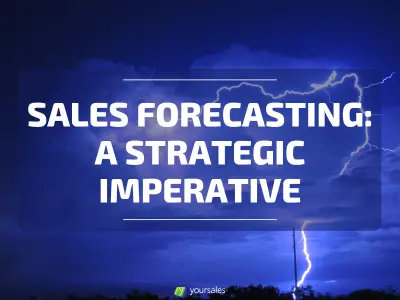Sales Forecasting:
A Strategic Imperative
Sales forecasting is a critical process for any B2B organization, particularly for companies operating in a highly competitive landscape. Sales leaders’ primary concern revolves around accurately forecasting future results. It empowers businesses to make informed decisions, allocate resources effectively, and achieve sustainable growth. In this article, we will dive into the essence of sales forecasting, exploring its significance, methodologies, and the tangible benefits it brings to the table.
This article is part of the series where we identify the top 5 problems sales leaders want Customer Relationship Management (CRM) systems to solve, what those problems really are, and the value of solving them. During the survey, sales forecasting for a long time held the #1 spot, and eventually secured the #2 spot. If you want to see what the other top 5 problems sales leaders want to solve are, then just follow the link.
So far we’ve previously been talking about:
- Top 5 Problems Sales Leaders Want CRM to Solve
- #3: Capturing Client & Prospect Communication: Unveiling the Powerful Key to Sales Success
- #4: Building and Growing Existing Accounts: The Vital Role of CRM
- #5: Data & Insights in CRM: Empowering Leaders and Teams
Defining Sales Forecasting:
Sales forecasting is the process of estimating future sales performance and revenue generation based on customer insights, historical data, market trends, and other relevant factors. It involves projecting future deals, sales volumes, analyzing customer demand, and predicting revenue streams within a given timeframe. By leveraging a blend of data analysis, market intelligence, and commercial expertise, sales forecasting provides valuable insights into the future trajectory of a company’s sales efforts.

The Importance of Sales Forecasting:
Strategic Decision-Making
Accurate sales forecasting equips leaders and executives with the necessary information to make well-informed strategic decisions. By understanding future sales projections, businesses can align their resources, develop realistic targets, and allocate budgets effectively. This enables realistic expectation-setting , optimal resource allocation, and enhances overall organizational efficiency.
Budgeting and Resource Allocation
A reliable sales forecast allows companies to allocate their resources efficiently. By estimating future revenue streams, organizations can determine the appropriate investment in marketing campaigns, sales training, customer acquisition, and retention strategies. Precise resource allocation enables cost control and ensures that the sales team has the necessary tools and support to achieve their targets.
Setting Realistic Goals
Sales forecasts enable businesses to set realistic and achievable goals. By understanding market dynamics, customer behavior, and internal capabilities, organizations can establish targets that align with their growth aspirations. Setting attainable goals motivates the sales team, improves morale, and helps create a culture of success, all of which are crucial for sustained growth.
Sales Performance Evaluation
Accurate sales forecasting facilitates the evaluation of sales team performance against predefined targets as well as against forecasted expectations. It provides a benchmark to measure individual and team achievements, identify gaps, and implement necessary corrective measures. Regular analysis of sales performance against forecasts enables managers to address issues promptly, recognize top performers, and optimize the overall sales process.
Resource Planning and Scalability
Sales forecasting is instrumental in long-term resource planning and scalability. By projecting future sales volumes, businesses can anticipate staffing requirements, infrastructure needs, and technological investments. It allows companies to prepare for growth, expand their sales force, and align their operational capacities with increasing market demand.

Forecasting Methodologies
Sales Funnel Analysis
Examining the sales funnel, from lead generation to conversion, is essential for accurate forecasting. By tracking and analyzing key performance indicators (KPIs) at each stage of the sales process, such as lead-to-opportunity conversion rates or average deal size, businesses can identify bottlenecks and optimize their sales funnel. This analysis helps estimate the number of leads and the funnel volume required to achieve sales targets and identify areas for improvement.
Historical Analysis
This method involves analyzing past sales data to identify patterns, trends, and seasonality. By examining historical performance, organizations can uncover insights into customer behavior, identify peak sales periods, and anticipate fluctuations. Historical analysis provides a solid foundation for forecasting, particularly for businesses with a substantial sales history.
Market Research and Competitive Analysis
Incorporating market research and competitive analysis can enhance sales forecasting accuracy. It involves studying market trends, industry reports, competitor performance, and customer preferences. By understanding market dynamics, businesses can adjust their strategies, identify market opportunities, and make more accurate predictions about future sales.
Customer Segmentation and Predictive Analytics
By segmenting customers based on their behavior, demographics, or purchasing patterns, businesses can leverage predictive analytics models. These models employ advanced statistical algorithms and machine learning techniques to identify customer preferences and predict future buying patterns. Customer segmentation and predictive analytics provide valuable insights into the potential value of each customer segment and enable personalized sales strategies.
Tangible Benefits of Sales Forecasting
Deliver on Expectations
Every company will have stakeholders such as a circle of owners, investors, and a board. These stakeholders will want to understand where the business is headed.
Consistently keeping an eye on sales forecasting accuracy makes this possible. With a solid and credible understanding of where the business is headed, stakeholders will consequently be able to add value by fulfilling their role in a way that matches the company’s needs at that moment.
Enhanced Revenue Predictability
Accurate sales forecasting enables companies to forecast revenue streams with greater precision. By understanding sales cycles, market trends, and customer behavior, businesses can reduce revenue uncertainties, improve cash flow management, and enhance financial stability.
Improved Inventory and Supply Chain Management
Sales forecasting helps optimize inventory and supply chain management. By predicting future demand, businesses can align their procurement processes, reduce excess inventory or stockouts, and improve overall supply chain efficiency. This leads to cost savings, improved customer satisfaction, and streamlined operations.
Effective Sales and Marketing Strategies
Accurate sales forecasting empowers businesses to develop effective sales and marketing strategies. By understanding customer preferences, market segments, and buying patterns, organizations can tailor their messaging, target the right audience, and optimize marketing investments. This leads to improved customer acquisition, higher conversion rates, and increased sales productivity.
Better Cash Flow Management
Sales forecasting assists in managing cash flow effectively. By estimating future sales volumes and revenue, businesses can anticipate cash inflows and outflows, enabling them to plan and manage their financial resources accordingly. This allows companies to invest in growth initiatives, meet financial obligations, and maintain a healthy cash position.
Improved Project Management and Delivery Times
Some businesses deliver their offering initially in the form of a project. Others dedicate scarce Customer Success resources to product implementation. Either way, knowing what’s coming down the pipeline makes it easier to plan. Resources are typically scarce and customers will often want to have their decision take effect as soon as possible.
Proper sales forecasting makes this achievable. It allows for faster delivery of projects, creating happier customers sooner.
Conclusion
As you can tell, sales forecasting is a fundamental process that drives growth and success for B2B companies. By leveraging historical data, market intelligence, and predictive analytics, businesses can accurately estimate future sales performance, make informed decisions, and allocate resources efficiently.
The importance of sales forecasting lies in its ability to facilitate strategic decision-making, goal setting, performance evaluation, and resource planning. Moreover, it empowers companies to achieve revenue predictability, improve inventory management, optimize sales and marketing efforts, and enhance cash flow management.
Embracing sales forecasting as a strategic imperative equips B2B sales teams with the necessary tools and insights to navigate the dynamic marketplace, achieve sustainable growth, and stay ahead of the competition.


